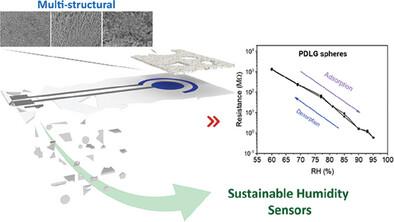Multi‐Structural and Biodegradable Humidity Sensors with Enhanced Surface Hydrophilicity
引用次数: 0
Abstract
The increasing environmental impact from electronic waste (e‐waste) has prompted research into sustainable materials for biodegradable and transient electronics. Although some progress has been achieved, further improvement in terms of performance and sustainability is needed. This study introduces a humidity sensor composed of biodegradable poly(D,L‐lactide‐co‐glycolide acid) (PDLG) in novel and multi‐structural morphologies. It highlights the role of the sensors’ microscopic structural features in their performance, particularly in humidity sensitivity, to maximize the retention and detection of water molecules. Techniques such as electrospinning and electrospray are used to achieve specific fiber and sphere morphologies. Oxygen plasma treatments tuned their surface hydrophilicity, enhancing moisture interaction. Physicochemical characterization revealed that plasma‐treated morphologies lost up to 93% of their weight after six weeks, demonstrating high sensor degradation. Functional tests showed that the sphere‐based sensor exhibited low hysteresis (0.19%), high sensitivity (3.9 × 10⁷ MΩ/% RH), excellent repeatability, and fast response time (0.43s) in the 60−95% RH range. Additionally, NaCl functionalization further improved detection sensitivity and extended the detection range down to 30% RH. The biodegradable nature of the PDLG sensors allows their natural decomposition into eco‐friendly by‐products, minimizing their environmental impact, and addressing the environmental challenges associated with e‐waste.

具有增强表面亲水性的多结构可生物降解湿度传感器
电子垃圾(e-waste)对环境的影响日益严重,促使人们对可生物降解和瞬时电子产品的可持续材料进行研究。虽然已经取得了一些进展,但还需要在性能和可持续性方面进一步改进。本研究介绍了一种由可生物降解聚(D,L-内酰胺-共聚乙二醇酸)(PDLG)组成的湿度传感器,具有新颖的多结构形态。它强调了传感器的微观结构特征在其性能中的作用,特别是在湿度灵敏度方面,以最大限度地保留和检测水分子。电纺丝和电喷雾等技术用于实现特定的纤维和球体形态。氧等离子处理可调整其表面亲水性,增强与湿气的相互作用。理化特性分析表明,经过等离子体处理的形态在六周后重量损失高达 93%,这表明传感器的降解率很高。功能测试显示,球形传感器在 60-95% 相对湿度范围内具有低滞后(0.19%)、高灵敏度(3.9 × 10⁷ MΩ/%相对湿度)、出色的重复性和快速响应时间(0.43 秒)。此外,NaCl 功能化进一步提高了检测灵敏度,并将检测范围扩展至 30% RH。PDLG 传感器的可生物降解特性使其能够自然分解为生态友好型副产品,从而最大限度地减少了对环境的影响,并解决了与电子垃圾相关的环境挑战。
本文章由计算机程序翻译,如有差异,请以英文原文为准。
求助全文
约1分钟内获得全文
求助全文

 求助内容:
求助内容: 应助结果提醒方式:
应助结果提醒方式:


